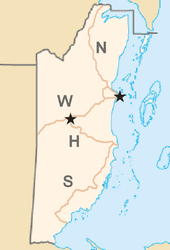Roads in Belize
The road network in Belize consists of over 3,000 kilometres (1,900 mi) of roads, of which approximately 575 kilometres (357 mi) is paved.[1]
Highways

Belize has four major asphalt-paved two-lane roads:
- Phillip Goldson Highway (formerly Northern Highway) between Belize City and the Mexican border north of Corozal (95 miles or 153 kilometres)
- George Price Highway (formerly Western Highway) between Belize City and the Guatemalan border near Benque Viejo del Carmen (81 miles or 130 kilometres)
- Hummingbird Highway from Belmopan to Dangriga (55 miles or 89 kilometres)
- Southern Highway from Dangriga to Punta Gorda
Most maps also display Old Northern Highway, which provides access to Altun Ha. This road is a single lane and paved in places, but deteriorates dramatically immediately north from the access road to the ruins.
There is also the Coastal Highway, also known as the Manatee Highway or the Shortcut, which joins the Western Highway 30 miles (48 km) west of Belize City with the Stann Creek Valley near Dangriga, but it is all gravel, and may wash out in heavy rains.
Bus
Most Belizeans travel by bus as their main form of transportation. In the large towns and cities, such as Belize City, tickets can be bought ahead of time at a bus terminal. However, the most common way of catching a bus is by flagging it down on the road. On the Phillip Goldson and George Price Highways, bus service is more frequent than on smaller highways and other roads. In some locations, like small towns, buses may run only once a day. Many buses are old Greyhounds or school buses, although newer express buses travel the two main highways. The express buses cost slightly more than other buses.
Travel by bus in Belize is inexpensive, with the total fare from Chetumal, Mexico, at the border in the north to Punta Gorda in the far south being only around BZD $40 (USD $20). Fares vary by route and bus line, but generally fares run around 5–7 US cents per mile (3.1–4.3 ¢/km). With the 2005 bankruptcy and closing of the largest national bus company, Novelo's, bus service in Belize has become more fragmented. National Transportation Services, effectively the successor to Novelo's, generally operates from the old Novelo's terminals, but almost 100 other bus lines, some with only one bus, also operate around the country. Among the larger lines are James, Tillett's, Belize Buses (a drivers' co-op) and Gilharry. Shuttle vans also operate, providing direct service between towns for a higher price. Two Guatemala-based bus lines, Linea Dorada and San Juan, have service from Chetumal, Mexico, to Flores, Guatemala, via Belize City.
Taxi
Taxis are unmetered, with fare schedules varying by city. Fares for travel outside the cities are based on the distance covered. Because taxis are unmetered, discussing the fare with the driver first is recommended. Typical rates within Belize City are BZ$5–10 (US$2.50–5). Taxi fare from the international airport to the Belize City center is fixed at BZ$50 (US$25), for up to four persons.
Bicycle
Bicycles have grown in popularity, but motorcycles and mopeds are fairly scarce, though with the price of gas now near BZ$10 (US$5) a gallon, small scooters and motorcycles are used more frequently than in the past.
Driving in Belize
Besides the highways, the rest of the roads are one or two lanes and typically unpaved, at times filled with gravel or sand. If trying to reach remote or off-the-main-road destinations, it is recommended to drive in a four-wheel drive vehicle. Driving requires a valid driver's license from your home country. There are occasional police check points usually near the major towns that may require you to stop and provide all the legal documents, as well as proof of the required liability insurance. There are plenty of gas stations near the larger towns, and mechanics may be found in Belize City, Belmopan, San Ignacio, and Orange Walk. Traffic is very light on the highways, and passing slower vehicles should cause no problems.
Sleeping policemen
These are the famous speed bumps at pedestrian crossings. They are always within a small village, but sometimes are unsigned, so it is wise to slow down when approaching a populated area.
Road rules
Driving is on the right side of the road. Speed limits are 55 mph (90 km/h) on the highways, and 25–40 mph (40–65 km/h) within villages and towns. Seatbelts are required. Mileposts and road signs still display distances in miles.
References
| ||||||||||